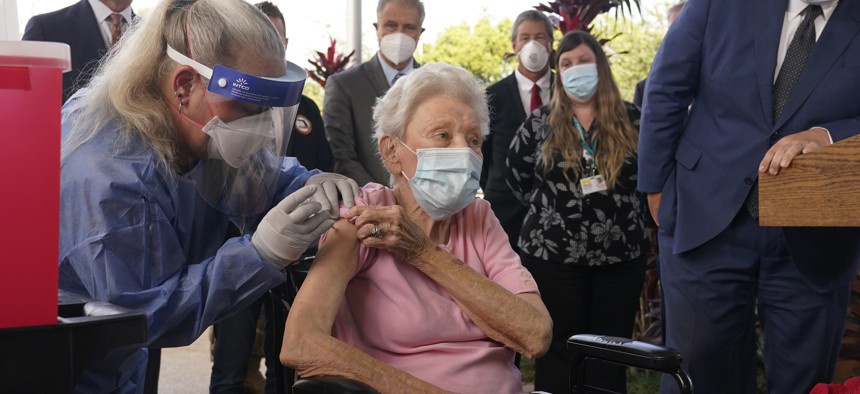Covid Infections Fall Steeply in Nursing Homes Since Vaccine Rollout

Nurse Christine Philips, left, administers the Pfizer vaccine to Vera Leip, 88, a resident of John Knox Village, Wednesday, Dec. 16, 2020, in Pompano Beach, Fla. AP Photo/Marta Lavandier
Since December, infection and death rates among residents and workers in long-term care facilities have significantly declined and fewer health care workers are refusing vaccines.
Covid-19 infections in nursing homes and long-term care facilities have dropped by 82% since the first coronavirus vaccines became available in December, according to a new report.
The data, collected by the American Health Care Association and National Center for Assisted Living, suggests that vaccinations of elderly residents and health care workers have helped dramatically cut the number of new infections and deaths in nursing homes.
The number of new weekly Covid-19 cases among nursing home residents peaked the week of Dec. 20 with 33,273 cases, according to Centers for Medicare and Medicaid Services data that the association analyzed. That number has dropped precipitously, to about 11,000 cases the week of Jan. 31 and 6,000 cases the week of Feb. 7.
The first Covid-19 vaccine in the United States was administered on Dec. 15 and vaccination efforts began in nursing homes in the final weeks of December.
The 82% decrease in new nursing home cases shows a greater decline than the 46% decrease in the general public. The data on new nursing home infections is “incredibly encouraging,” said Mark Parkinson, president and CEO of AHCA/NCAL.
“This new data showcases just how important it is for nursing homes’ residents and staff, as well as the general public, to get the vaccine because it is clearly working,” Parkinson said.
President Biden announced an expansion in vaccine manufacturing efforts Tuesday that he said puts the United States on track to have enough Covid-19 vaccine doses for every adult American by the end of May.
Long-term care facilities were hard hit by the coronavirus pandemic. The virus killed more than 172,000 residents and employees of the facilities, accounting for about a third of the nation’s Covid-19 deaths.
Because of the high infection and death rates, residents and employees of nursing homes were among the first eligible to be vaccinated. But there was some initial hesitation among health care workers concerned about the safety and effectiveness of the vaccines. A December survey of 2,500 health care workers, including 435 employees of long-term care facilities, found 15% had already refused the shots.
As the vaccine has been more widely distributed, the refusal rate among health care workers has declined.
Surgo Ventures, which conducted the December survey, followed up with the health care workers who declined vaccinations. In a February survey, they found 20% of the workers who initially refused to take the vaccine had changed their minds. That brought health care workers’ vaccine refusal rate down to 11% from 15%.
Continuing to reduce infection rates in long-term care facilities will require more work to vaccinate care-workers and staff, Parkinson said. But the initial rollout appears to be helping lower the death rate in nursing homes.
The weekly number of coronavirus-related deaths in nursing homes reached a peak of 5,932 on Dec. 20. The weekly number of deaths declined 63% to 2,211 the week of Feb. 7.
By comparison,10,837 infections and 3,461 deaths were reported in nursing homes the week of May 31 last year, the first week the Centers for Medicare and Medicaid Services started tracking the data.
As the situation improves, Parkinson called on the Biden administration to revise guidance that restricts visitors and activities at nursing homes.
“With millions of residents and caregivers now fully protected thanks to the vaccines, residents must be able to safely reengage in meaningful activities and be reunited with their loved ones,” he said.
Andrea Noble is a staff correspondent with Route Fifty.

NEXT STORY: Travel Bans do Little to Stem Covid-19 Spread





